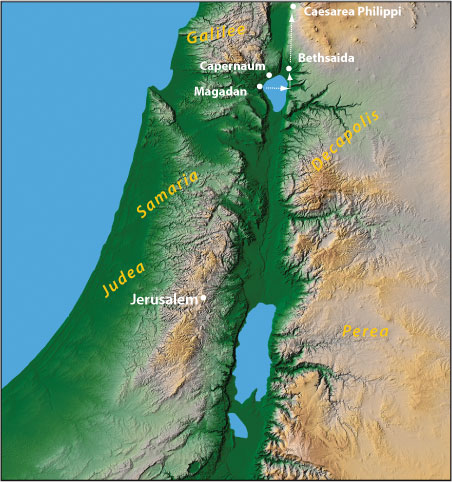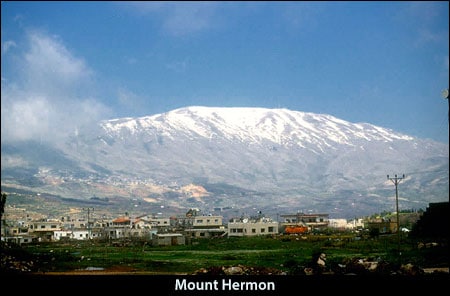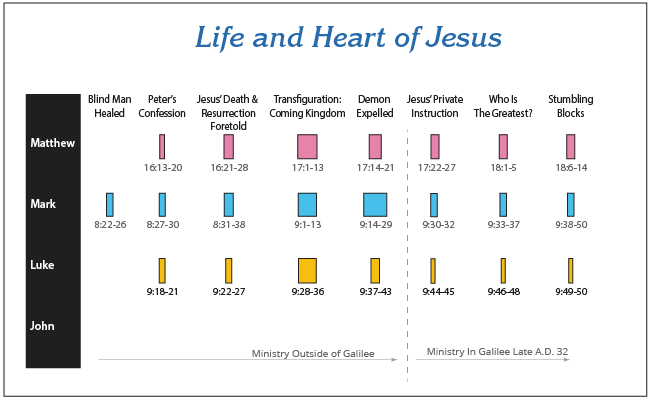This study comes after an important sequence of events. Peter has just confessed that Jesus is “the Christ, the Son of the living God.” It was an unexpected, however, true statement. In response, Jesus started showing the disciples that He must go to Jerusalem and die. Peter objected because he did not understand that sometimes tragedy is actually beneficial. Then Jesus rebuked Peter declaring that Satan had motivated his comment. Jesus proceeds to tell the disciples that a true disciple is one who is willing to suffer for Him just like those who had died on crosses. Jesus talked about carrying a cross. The disciples understood all about crosses because they had seen many die on that horrible Roman instrument of death during their short lives. The Son of the living God told them that in order to truly be His followers they must die to themselves. Then Jesus surprised them when He said that some of them would see the Son of Man coming in His kingdom before they died.
The Problem
I wonder which of the disciples wanted to see Jesus coming into His kingdom? Did Judas, Matthew or Thomas? I believe that Peter and John wanted to see Jesus come into the kingdom. If we only could have looked into their hearts or heard their thoughts.
What did Jesus mean by this statement? It is obvious to anyone looking at this world today that the kingdom of God has not arrived. The peace, serenity and glory that God has promised (Isaiah 11:1-10) would exist in the kingdom is proof that the kingdom has not arrived yet. We do not have the promised peace and serenity nor do we see the glory of God in our world today, except in the creation and transformed lives. So what did Jesus mean that some would see the kingdom? Did Jesus lie? No! The answer will be provided later in this study.

I suspect that the disciples thought Jesus would actually set-up His earthly kingdom – the one promised by the prophets. I also wonder how many of the disciples were looking forward to that promised event? Did any of them wonder how long, and who would get to see it?
The Select Men
The event that Jesus had referred to is described in three passages: Matthew 16:28-17:13; Mark 9:1-13 and Luke 9:28-36.
The gospel of Luke says the event occurred eight days later (Luke 9:28) but Matthew and Mark say it was six days.
Six days later Jesus took with Him Peter and James and John his brother, and led them up on a high mountain by themselves. Matthew 17:1 ( NASB)
Six days later, Jesus took with Him Peter and James and John, and brought them up on a high mountain by themselves . . . Mark 9:2 ( NASB)
Some eight days after these sayings, He took along Peter and John and James, and went up on the mountain to pray. Luke 9:28( NASB)
Most likely Luke includes portions of the day before and after the six days that Matthew and Mark mention. Luke was a medical doctor and exact in his descriptions. A careful reading of the gospel of Luke and Acts bears witness to his passion for detail.

To the disappointment of some disciples – I am sure – Jesus took only three disciples with Him up to a high mountain; Peter, James and John (Matthew 17:1; Mark 9:2; Luke 9:27). These men were part of Jesus’ inner circle. Later near the end of Jesus’ ministry the inner circle is reduced to Peter and John. But at this point, the inner circle is three men. From Luke 9:32 it is clear that Peter is the leader now in the ministry. These were men who loved Jesus. It appears that Jesus was preparing them for future service.
Most likely the mountain the four men ascended was Mount Hermon which is located near Caesarea Philippi. Matthew 17:1 and Mark 9:2 say it was a high mountain and the highest mountain in the area is at an elevation of 9,732 feet. It was not too far from the city of Bethsaida on the east side of the Sea of Galilee.

The Visitors
The men climbed the mountain. We are not told how long this took or if it was cold or warm during the climb. It is amazing what scripture does not tell us. Once on the mountain, Jesus allowed the men to see Him transfigured.
And He was transfigured before them; and His face shone like the sun, and His garments became as white as light. Matthew 17:2 (NASB)
The Greek word that is translated as “transfigured” comes from the word metemorphothe from which we get the English word metamorphosis. That is, Jesus changed from His human form into the glory that He had when He was in heaven before He came to earth. John 17:5 reminds us that Jesus had glory when He was in heaven – the Shekinah glory (Ezekiel 43:2-5).
Now, Father, glorify Me together with Yourself, with the glory which I had with You before the world was. John 17:5 (NASB)
What did Peter, James and John see? What would you have seen? What did they realize? Why did Jesus bring only these three men along? I do not believe that this journey was so much for the benefit of Jesus as it was for the spiritual growth of these disciples. These men did not know what was going to await them on the secluded mountain. But Jesus knew these men needed this experience. They needed to see more of Jesus – His glory. There is an important lesson here. Do you want to see more of Jesus? If so, you need to get alone on a “high mountain” in order to see His glory. This adventure was not about discovering something about themselves. The adventure was all about Jesus. For me, my high mountain is a recliner and I find some greatest “visions” of Jesus in the pages of scripture. I hope you do too!

The gospel of Luke says the transfiguration occurred while Jesus was praying,
And while He was praying, the appearance of His face became different, and His clothing became white and gleaming. Luke 9:29 (NASB)
Jesus’ face was changed and His clothing turned white and started shining. Matthew 17:2 says that His face was like the sun. That means His face was extremely white and bright. What an experience these men had.
We are also told that two men joined Jesus. They were Moses and Elijah.
And behold, two men were talking with Him; and they were Moses and Elijah, who, appearing in glory, were speaking of His departure which He was about to accomplish at Jerusalem. Luke 9:30-31 (NASB)
While we cannot be sure, I believe that Moses and Elijah are the two witnesses that will appear during the Tribulation Period that are mentioned in Revelation 11:1-6. Revelation 11:6 describes an event that will occur before the kingdom. It is a pre-kingdom event. When we realize that Jesus promised the disciples that some of them would see the kingdom, we can confidently say that Moses and Elijah will be present in the kingdom and Peter, James and John had a glimpse of the future earthly kingdom. It is reasonable to conclude that Moses and Elijah will participate in both the Tribulation and kingdom. Next we are told that Moses and Elijah were talking with Jesus about His death, resurrection and ascension. This reveals that they and heaven knew what was going to happen. They knew the plan, but earth did not know the plan.
Sometime during the discussion the three disciples fell asleep.
Now Peter and his companions had been overcome with sleep; but when they were fully awake, they saw His glory and the two men standing with Him. Luke 9:32 (NASB)
I am amazed that they fell asleep. Why would they fall asleep just when incredible things are occurring? The answer may be that the time on the mountain had continued into the early morning hours. Yet, weren’t they thrilled enough to stay awake to experience these incredible events? Regardless of how these men reacted, Jesus was no ordinary man. He was the God of the universe and His glory was on display!
Peter’s Idea
It is obvious from the next verse that Peter understood that this was an incredible event. So he volunteered what I am sure he thought was a terrific idea.
And as these were leaving Him, Peter said to Jesus, “Master, it is good for us to be here; let us make three tabernacles: one for You, and one for Moses, and one for Elijah” — not realizing what he was saying. Luke 9:33 (NASB)
He suggested that they make three tabernacles. One for Jesus, one for Moses and the third for Elijah. It is possible that this event occurred during the month of Tishri (approx. September-October). If so, this could have been the time for the Feast of Tabernacles or the Feast of Booths. The Feast of Booths lasted about seven days and during the feast the Jewish people would live in booths as a reminder that the Jews lived in tents during their wanderings in the desert as they journeyed towards the Promised Land. Therefore, if this event occurred during the month of Tishri, Peter could have been thinking that he should make a booth for them. If so, he was not thinking very clearly – that is the message of verse 33. The verse concludes with “- not realizing what he was saying.” Mark adds,
For he did not know what to answer; for they became terrified. Mark 9:6 (NASB)
His fear resulted in a “knee-jerk” reaction. His comment was foolish because Moses and Elijah were heavenly visitors who would return to heaven. They were not planning to stay.

The Heavenly Voice
Then we are told that a cloud covered them on that high mountain and their fear grew even worse.
While he was saying this, a cloud formed and began to overshadow them; and they were afraid as they entered the cloud. Luke 9:34 (NASB)
Matthew adds that the cloud was bright and surrounded them. Luke reveals that the cloud gradually formed around them – “as they entered.”
Then a voice came out of the cloud, saying, “This is My Son, My Chosen One; listen to Him!” Luke 9:35 (NASB)
Matthew 17:5 adds the phrase, “with whom I am well-pleased.” Peter, James and John heard God the Father speaking. The message was that Jesus was God the Son and they needed to listen to Him. These men really did not understand Jesus. They had God – Jesus – in their very presence and they were listening to God at an altitude of 9,200 feet. Wow, what an experience. They had a glimpse of the future kingdom, just as Jesus promised. Matthew 17:6 says that the men fell to the ground with their faces on the ground.
Then the transfiguration of Jesus ended.
And when the voice had spoken, Jesus was found alone. And they kept silent, and reported to no one in those days any of the things which they had seen. Luke 9:36 (NASB)
The first part of Luke 9:36 states that after God the Father had spoken, Moses and Elijah left and Jesus was alone. Matthew reveals that the men still had their faces down and, probably, eyes looking into the ground. After Jesus was left alone, He touched the men and encouraged them. This shows His great compassion.
And Jesus came to them and touched them and said, “Get up, and do not be afraid. And lifting up their eyes, they saw no one except Jesus Himself alone. Matthew 17:7-8 (NASB)
Descent From The Mountain
When the transfiguration was over, it was time to leave the mountain. I wonder if they wanted to leave? What were they feeling? Was Peter embarrassed? Did they want to stay a little longer? We do not know because we are told very little. However, we are told that they had a conversation as they descended the mountain.
We do not know if they spent the evening on the mountain or if they left immediately. Matthew, Mark and Luke only report that they left the mountain and while they were descending, a conversation followed. It is doubtful that we are told everything they discussed. We are only given the important topics. The most important one was Jesus’ command or warning to the three disciples to not tell anyone about the events they had experienced. Luke 9:36 is terse (Luke 9:36b) but Matthew gives us the most detail,
As they were coming down from the mountain, Jesus commanded them, saying, “Tell the vision to no one until the Son of Man has risen from the dead.” Matthew 17:9 (NASB)
Mark adds that they could not tell anyone about their experience until after His resurrection.
As they were coming down from the mountain, He gave them orders not to relate to anyone what they had seen, until the Son of Man rose from the dead. They seized upon that statement, discussing with one another what rising from the dead meant. Mark 9:9 -10 (NASB)
Matthew now gives us another topic that they discussed. The topic was the chronology of the future. These three men understood that they had seen what Jesus had promised in Matthew 16:28 – the coming of the kingdom – and now they want to know more. Jesus answers by giving them an outline of events yet to come.
And His disciples asked Him, “Why then do the scribes say that Elijah must come first?” And He answered and said, “Elijah is coming and will restore all things; but I say to you that Elijah already came, and they did not recognize him, but did to him whatever they wished. So also the Son of Man is going to suffer at their hands.” Then the disciples understood that He had spoken to them about John the Baptist. Matthew 17:10-13 (NASB)
Their questions were natural. They had heard and been taught that Elijah had to come first. They were struggling with the chronology. Did they wonder why Jesus had to die? Jesus had performed miracles, signs, and wonders. He had been a magnificent teacher. He was the Christ, and they had just seen Him gleaming, brilliant, and glowing like the sun with Elijah and Moses. Why couldn’t Jesus do just whatever He wanted? If that was what they were thinking, they were wrong because Jesus could do whatever He wanted.
Elijah had come in the power and likeness of John the Baptist (Luke 1:17). Mark 1:2-3 connects the prophecies of Isaiah 40:3 and Malachi 3:1 to John the Baptist. This means that John the Baptist was the forerunner of the Messiah as predicted in the Old Testament. So Jesus told them, “Elijah already came.” John the Baptist was not really Elijah, but he came in the spirit of Elijah. Jesus would die next, then be resurrected and ascend back to heaven. Then Elijah would come in the future, before Jesus’ second coming when He will establish the kingdom. Therefore, Jesus told them that Elijah “will restore all things.” John the Baptist was not Elijah.
Conclusion
Jesus had asked the men to keep the events that they had experienced a secret until after His death sometime after His death the apostle Peter gave this brief account in his second epistle,
For we did not follow cleverly devised tales when we made known to you the power and coming of our Lord Jesus Christ, but we were eyewitnesses of His majesty. For when He received honor and glory from God the Father, such an utterance as this was made to Him by the Majestic Glory, “This is My beloved Son with whom I am well-pleased” — and we ourselves heard this utterance made from heaven when we were with Him on the holy mountain. 2 Peter 1:16-18 (NASB)
Peter saw the glory of our Lord Jesus. He saw the coming of Jesus in a marvelous way. He heard God the Father, the Glory of glories speak from heaven. He had a glimpse of the kingdom. In this passage we have been given a glimpse of the coming kingdom – Jesus, our Holy One, shining in white and radiant.